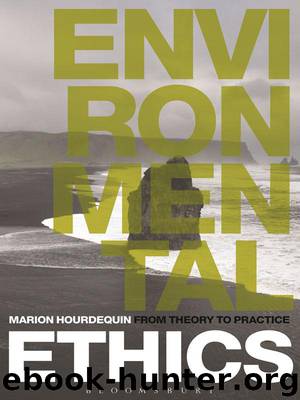Environmental Ethics: From Theory to Practice by Hourdequin Marion

Author:Hourdequin, Marion [Hourdequin, Marion]
Language: eng
Format: azw3
ISBN: 9781472507617
Publisher: Bloomsbury Publishing
Published: 2015-01-28T16:00:00+00:00
Ethics, institutions, and infrastructure
The word “institution” sounds formal, and even distant from daily life. But the core meaning of the word is quite broad. The Merriam-Webster’s Dictionary defines institution as a “a significant practice, relationship, or organization in a society or culture.” High school graduation ceremonies in the United States, for example, are a cultural institution, as is afternoon tea in England, or asado barbeques in Argentina. Institutions can be more elaborate, of course. They include the legal and political systems of a particular society, its educational structure, social welfare programs, financial organizations, and so on.
From birth, we are embedded in institutions. In most parts of the world, tiny babies are soon named, their birth certificates are written, and they enter into citizenship in a particular nation. Our engagement with various institutions often confers various privileges and responsibilities. Institutions are full of norms, laden with values.
Take, for example, educational institutions. Some of the norms and values they promote are intentional and explicit. My children’s elementary school emphasizes “teamwork” and “respect” as core values. The school explicitly teaches these values with posters displayed in each classroom emphasizing their importance. Yet, the school imparts other values implicitly, and not necessarily intentionally. Such implicit values—and associated practices—are known as “the hidden curriculum.” The lunchroom practices at the school provide an example. All of the lunch trays, tableware, and napkins provided for school lunches are used once, then discarded, creating enormous piles of refuse. Yet, this garbage magically disappears each day, enabling the process to start anew at the following lunch hour. Whether intentional or not, the practice of using throwaway lunch trays reinforces an existing social orientation toward the “convenience” of disposable goods.
To calculate the environmental costs of using disposables instead of reusable plates, glasses, and silverware, we would need to do a full lifecycle analysis of each alternative, looking at the energy required to manufacture each kind of plate, the energy and water used in washing reusable plates, the environmental impact of disposing foam lunch trays, and so on. In general, if plates are reused over their full lifespan and washed in energy- and water-efficient dishwashers, they win out in the environmental calculus.
However, there is more at stake than whether the reusable plates win out in this particular case (though that is not irrelevant). Do we really want to instill in children the values associated with single use and disposal? A recent story on National Public Radio in the United States reported that some Americans apply this ethic not only to food containers, but also to clothing. With clothes so cheap, why bother washing them? One person interviewed explained that when he runs out of clean socks, he simply tosses the old ones and heads to the store for a new set. While this example may be extreme, Americans throw out 78 pounds of textiles each year, on average—not including the 1.1 billion pounds of used clothing exported by the United States to other countries (Schor 2010, p. 39).
Returning to the school example, we can see the connections between institutions, values, and infrastructure.
Download
This site does not store any files on its server. We only index and link to content provided by other sites. Please contact the content providers to delete copyright contents if any and email us, we'll remove relevant links or contents immediately.
Enlightenment Now: The Case for Reason, Science, Humanism, and Progress by Steven Pinker(7228)
A Journey Through Charms and Defence Against the Dark Arts (Harry Potter: A Journey Through…) by Pottermore Publishing(4781)
The Immortal Life of Henrietta Lacks by Rebecca Skloot(4525)
A Journey Through Divination and Astronomy by Publishing Pottermore(4344)
Elon Musk by Ashlee Vance(4028)
Origin Story: A Big History of Everything by David Christian(3648)
COSMOS by Carl Sagan(3554)
Alchemy and Alchemists by C. J. S. Thompson(3449)
Bad Pharma by Ben Goldacre(3355)
Enlightenment Now by Steven Pinker(3335)
Shadow of Night by Deborah Harkness(3302)
Inferior by Angela Saini(3276)
A Mind For Numbers: How to Excel at Math and Science (Even If You Flunked Algebra) by Barbara Oakley(3217)
Origin Story by David Christian(3147)
The Code Book by Simon Singh(3074)
Signature in the Cell: DNA and the Evidence for Intelligent Design by Stephen C. Meyer(3071)
The Elements by Theodore Gray(2998)
A Brief History of Time by Stephen Hawking(2960)
A Journey Through Potions and Herbology (A Journey Through…) by Pottermore Publishing(2826)
